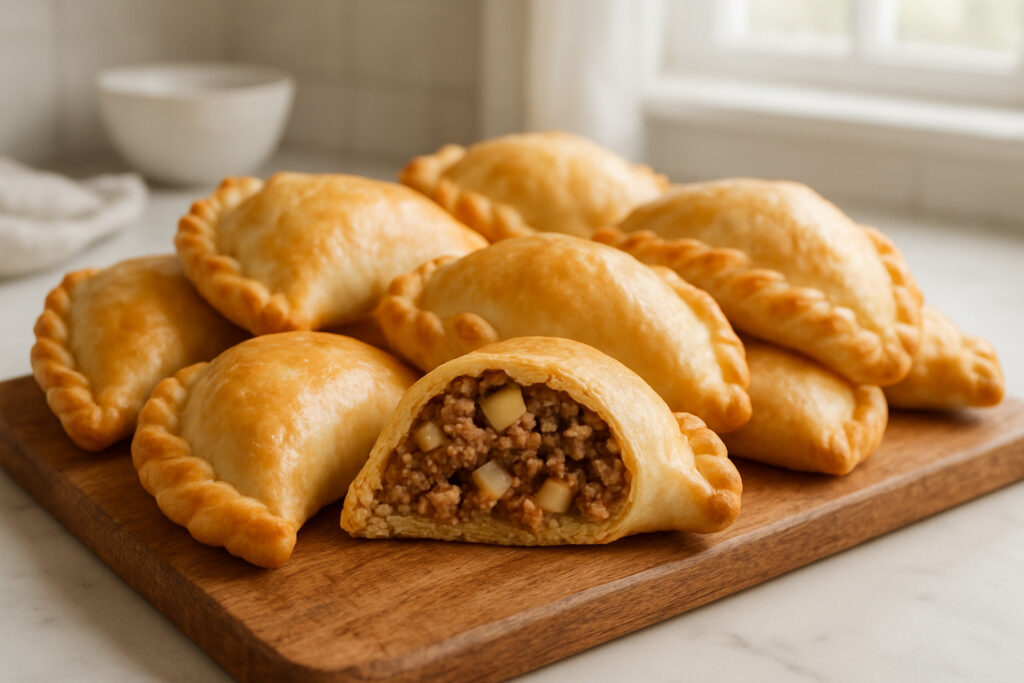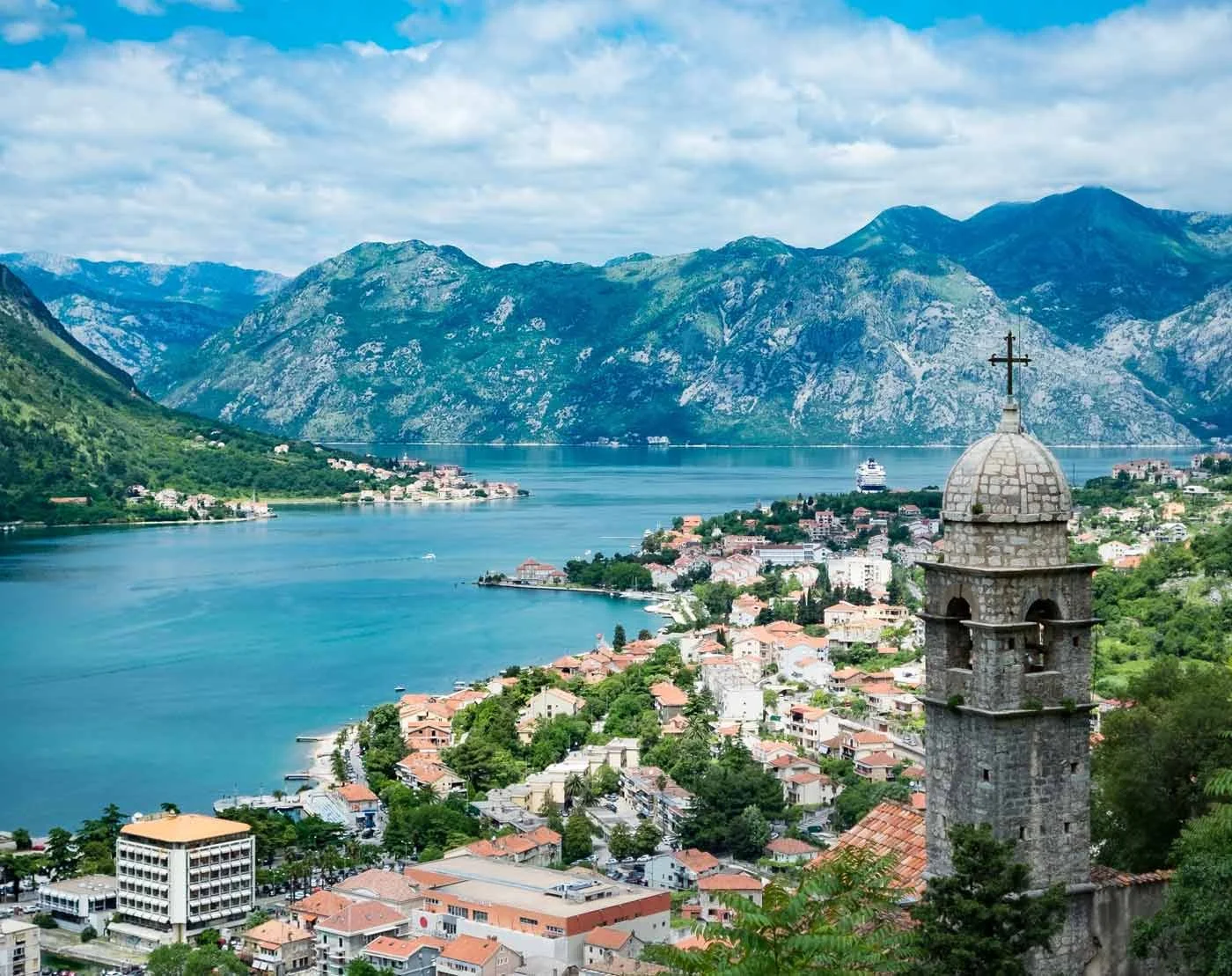What Makes Empanadas the World’s Perfect Handheld Food
Empanadas are baked or fried turnovers made with pastry dough wrapped around savory or sweet fillings. These golden, crescent-shaped pockets originated in medieval Spain and have become beloved comfort food across Latin America, the Philippines, and beyond.
Quick Facts About Empanadas:
- What they are: Pastry turnovers with meat, cheese, or sweet fillings
- Where they’re from: Originally Galicia, Spain (dating back to the 1500s)
- How they’re made: Dough rolled thin, filled, sealed, then baked or fried
- Popular varieties: Argentine beef, Chilean pino, Filipino chicken, sweet plantain
- Serving style: Hand-held snacks, appetizers, or main meals
Think of empanadas as the ultimate fusion food – they’ve traveled the world and adapted to local tastes everywhere they’ve landed. In Argentina, they’re stuffed with spiced beef and hard-boiled eggs. In the Philippines, they feature chicken and vegetables.
What makes empanadas so special is their versatility and portability. They work as street food, party appetizers, or hearty meals. You can bake them for a lighter option or fry them for extra crispiness. They freeze beautifully and reheat perfectly – making them ideal for busy food lovers who want authentic flavors without the fuss.
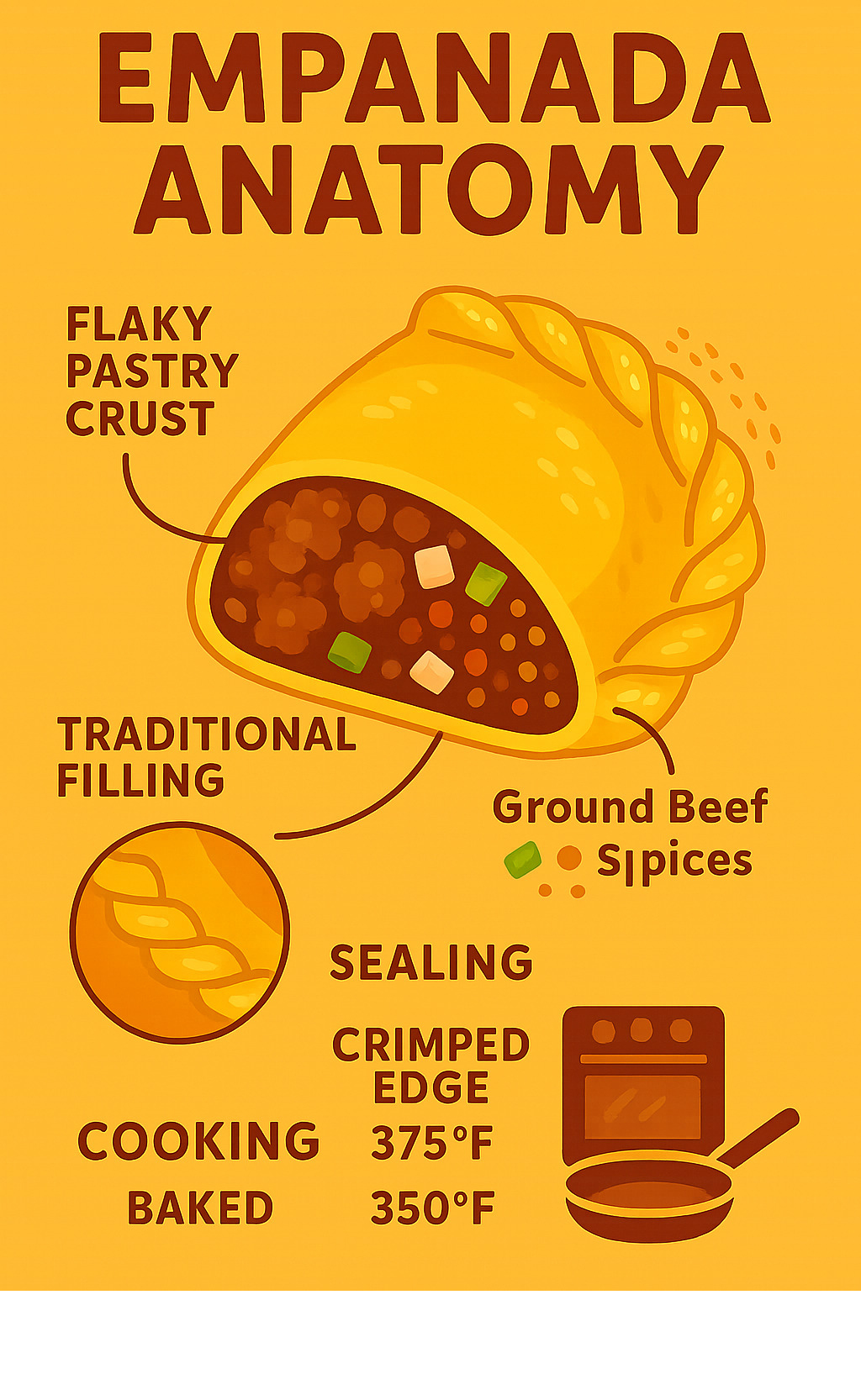
Key empanadas vocabulary:
What Are Empanadas?
The word “empanada” comes from the Spanish verb “empanar,” which means “to bread” or “to wrap in pastry.” At its heart, an empanada is a turnover pastry made by folding dough around a filling and sealing the edges.
The dough itself can be made from wheat flour for a classic, flaky texture, corn flour for a heartier bite, or even mashed plantain in some Central American traditions. Some cooks add butter or lard for that perfect flaky crust, while others incorporate eggs and milk to create a more tender texture.
Empanadas shine in their versatility – they can be either savory or sweet, making them perfect for any time of day. Savory versions might be packed with seasoned ground beef, melted cheese, roasted vegetables, or fresh seafood. Sweet empanadas often feature tropical fruits, rich chocolate, or creamy dulce de leche.
This incredible portability sets empanadas apart from other filled pastries. They’re equally at home as a grab-and-go breakfast, a satisfying lunch, or neat appetizers at your next dinner party. The meal versatility of empanadas means they adapt to whatever occasion you have in mind.
Nutritional Snapshot & Portion Sizes
A large chicken empanada weighing about 222 grams packs approximately 580 calories, along with 32 grams of fat, 50 grams of carbohydrates, and 19 grams of protein. The calorie count mainly comes from the pastry dough and how it’s cooked.
Mindful eating with empanadas means paying attention to portion sizes and cooking methods. Here’s how baked and fried empanadas compare:
| Method | Calories | Total Fat | Saturated Fat | Protein |
|---|---|---|---|---|
| Baked | 400-450 | 18-22g | 8-10g | 15-18g |
| Fried | 500-580 | 28-32g | 12-17g | 17-20g |
Per large empanada (200-220g)
The sodium content can be high – around 1000mg per large empanada – so consider them an occasional treat. On the bright side, empanadas provide valuable nutrients like iron, delivering about 23% of your daily value in a single serving.
The History & Global Journey of Empanadas
The story of empanadas begins in medieval Spain, specifically in Galicia, where fishermen and farmers first finded the magic of wrapping food in pastry. The earliest written recipes appear in the 1520 Catalan cookbook “Llibre del Coch” by Robert de Nola, but empanadas were already making appearances much earlier.
The Moorish influence on Iberian cuisine during the 8th century brought stuffed pastry techniques from the Middle East. These culinary traditions had traveled the ancient Silk Road, carrying flavors and techniques from Persia and Arabia. Those early Galician empanadas were often stuffed with fresh seafood.
Then came Spanish colonization in the 16th century. Spanish explorers and settlers packed their empanada-making skills and sailed to the Americas. What happened next was pure culinary magic – each region took this basic concept and created entirely new versions using local ingredients and cooking methods.
In Argentina, empanadas became so deeply woven into the cultural fabric that the government declared the Creole empanada a Cultural Heritage of Food and Gastronomy. Today, the country celebrates with a National Empanada Festival in Tucumán.
The modern street food boom has launched empanadas into global stardom. You can now find them in major cities worldwide, with food trucks and restaurants serving everything from traditional Argentine beef to creative fusion varieties. Food lovers can explore these flavors through Street Food Tours, while home cooks can master the techniques using resources like the Cookbook: Empanada.
Similar Cousins Around the World
Empanadas are part of a delicious global family of filled pastries. The Indian samosa is probably empanadas’ closest cousin, featuring that same brilliant concept of crispy pastry wrapped around spiced fillings. Italy gave us the calzone, while Britain contributed the Cornish pasty – sturdy pastries designed as complete portable meals for miners.
Chinese dumplings represent another beautiful branch of this family tree. For a deeper dive into this fascinating world, check out our comprehensive guide to Dumplings.
What’s amazing is how each culture solved the same basic challenge: creating a portable, satisfying meal that doesn’t require utensils. Russian pirozhki, Jewish knish, and Malaysian karipap all represent local answers to this universal need.
Regional Styles and Fillings

The beauty of empanadas lies in how they’ve transformed as they’ve traveled the world. Each region has acceptd this humble pastry and made it their own, creating a delicious mix of flavors that tells the story of local ingredients and cultural influences.
In Argentina, they’re deeply woven into cultural identity – every province has its own style. Chile takes a different approach with larger, typically baked empanadas. Their beloved empanada de pino combines beef, onions, hard-boiled eggs, black olives, and raisins.
The Philippines offers perhaps the most dramatic variation, using rice flour dough with longganisa sausage, vegetables, and egg. In Belize, you’ll find panades made with corn dough and deep-fried. Ecuador’s famous empanadas de viento (wind empanadas) puff up during frying, creating light, airy pastries filled with melted cheese.
Classic Argentine Empanadas
Argentina has liftd empanadas to an art form. The most famous variety is the Empanada Tucumana, featuring juicy beef filling with onions, hard-boiled eggs, green olives, and cumin, all wrapped in tender, slightly sweet dough.
The Empanada Salteña from Salta province is often larger and more substantial, incorporating potatoes and spicier seasonings. What makes Argentine empanadas special is their obsession with balance – the filling should be juicy but not wet, flavorful but not overpowering.
The repulgue – the decorative crimping technique used to seal the edges – is considered serious business in Argentina. Each region has its preferred style, and the pattern helps identify the filling while ensuring proper sealing.
Sweet Empanadas Across Cultures
Sweet empanadas offer delightful surprises that showcase this pastry’s versatility. El Salvador’s sweet empanadas made with ripe plantain dough use the natural sweetness of plantains, eliminating the need for added sugar.
Apple-cinnamon empanadas have found devoted following in Mexican communities, while Argentina’s dulce de leche empanadas represent ultimate sweet satisfaction. Modern trends have introduced Nutella-banana combinations and even ice cream empanadas.
How to Make Empanadas at Home
Creating empanadas at home is surprisingly doable and deeply satisfying. The magic happens in your own kitchen with simple ingredients and techniques.
For the dough, you’ll need 3 cups all-purpose flour, 1 teaspoon salt, 1/2 cup cold butter (cubed), 1 large egg, 1/2 cup cold water, and 1 tablespoon white vinegar. The vinegar helps create that perfect tender texture.
Combine flour and salt, then work in cold butter until the mixture looks like coarse crumbs. Whisk egg, water, and vinegar together, then gradually stir into your flour mixture until a soft dough forms. Wrap in plastic and refrigerate for at least 30 minutes.
For classic beef filling, brown 1 pound ground beef with 1 diced onion and 2 minced garlic cloves. Season with cumin, paprika, salt, and pepper. Once cooled completely, fold in 2 chopped hard-boiled eggs and 1/4 cup chopped green olives.
Roll chilled dough to 1/8-inch thickness and cut into 5-6 inch circles. Place 2-3 tablespoons of filling slightly off-center, fold the dough over and seal edges with a fork. Bake at 400°F for 20-25 minutes or fry at 350°F until golden.
These empanadas are incredibly make-ahead friendly. You can prep components a day ahead, or assemble and freeze for up to three months. For more global cooking inspiration, explore our World Cuisine Exploration guide.
Essential Tools & Techniques
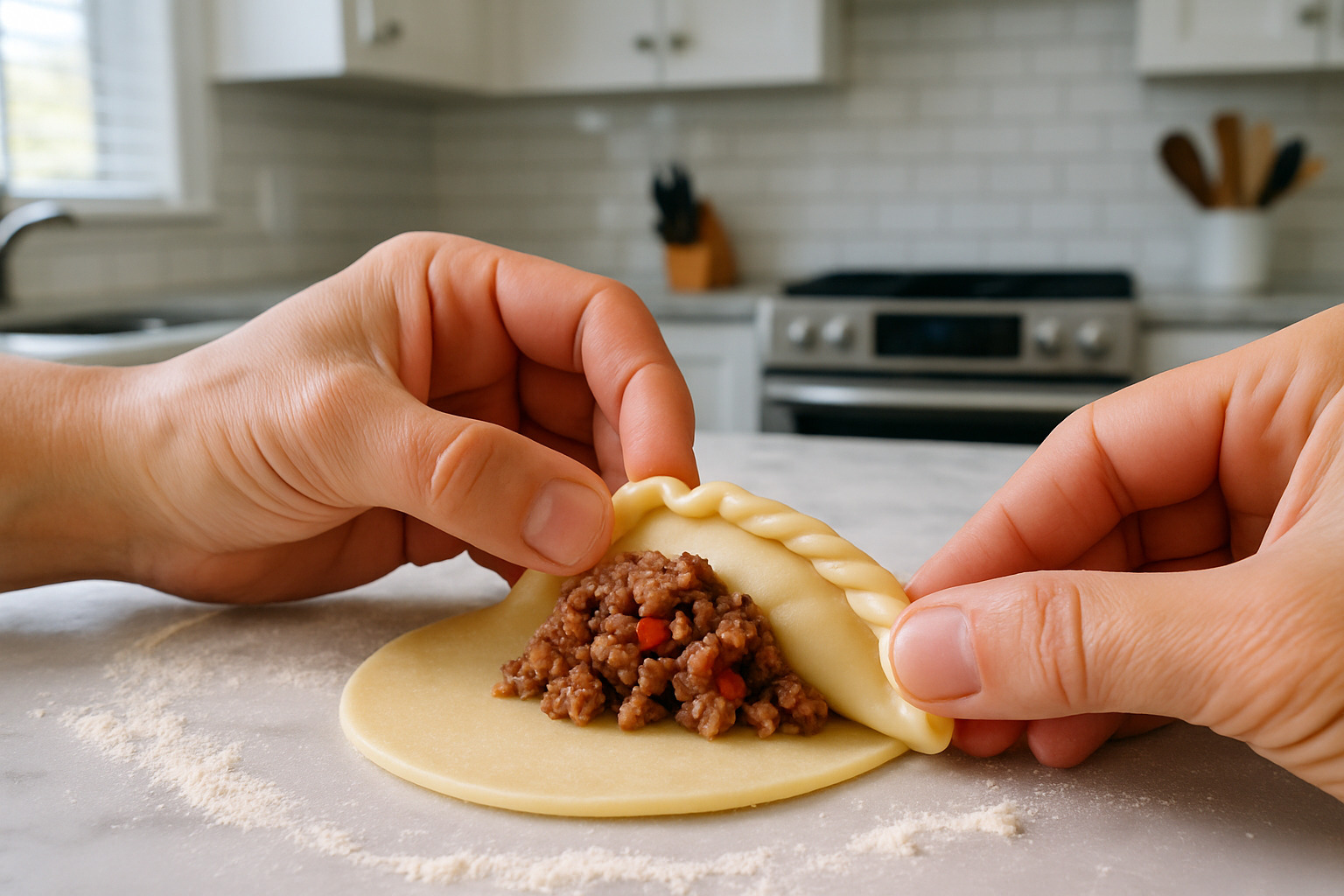
Making great empanadas isn’t about fancy equipment – it’s about understanding key techniques. Your rolling pin is essential for rolling dough evenly to 1/8-inch thickness. A round cookie cutter or small bowl helps create uniform circles.
Place 2-3 tablespoons of filling slightly off-center, leaving a 1/2-inch border. The repulgue (sealing technique) can be simple fork pressing or the traditional rope technique.
Temperature control is crucial. For frying, maintain 350°F – too hot burns the outside, too cool creates greasy empanadas. For baking, 400°F is perfect. Brush with beaten egg for gorgeous golden finish.
Healthier Empanadas & Dietary Options
Empanadas adapt easily to different dietary needs. Whole wheat flour can replace half the all-purpose flour for extra fiber. For gluten-free options, masa harina (corn flour) creates authentically delicious empanadas.
Plant-based empanadas work beautifully with seasoned black beans, roasted vegetables, or lentil “picadillo” seasoned like ground meat. For vegan dough, swap butter for vegetable shortening and replace egg with flax egg.
Air frying revolutionizes healthier cooking. Brush assembled empanadas lightly with oil, then air fry at 375°F for 12-15 minutes. Mini empanadas using 3-4 inch circles provide perfect portion control with half the calories.
Serving, Pairings & Modern Twists
The magic of empanadas comes alive with the right accompaniments. Chimichurri remains the classic choice for Argentine empanadas, while Peruvian ají sauce brings welcome heat. Mexican salsa verde adds tangy complexity, and simple aioli makes an excellent dipping sauce.
Modern chefs have acceptd empanadas as the perfect canvas for fusion creativity. Korean BBQ empanadas topped with kimchi have become food truck favorites, while Nutella-banana dessert versions satisfy sweet cravings. In New York City, innovative restaurants push boundaries with Indian curry-spiced fillings and Mediterranean combinations.
Empanadas adapt beautifully to different serving styles – from street-style snacks wrapped in paper to neat tapas platters. For more fusion street food innovations, explore our guide to Birria Tacos.
Beverage & Side Suggestions
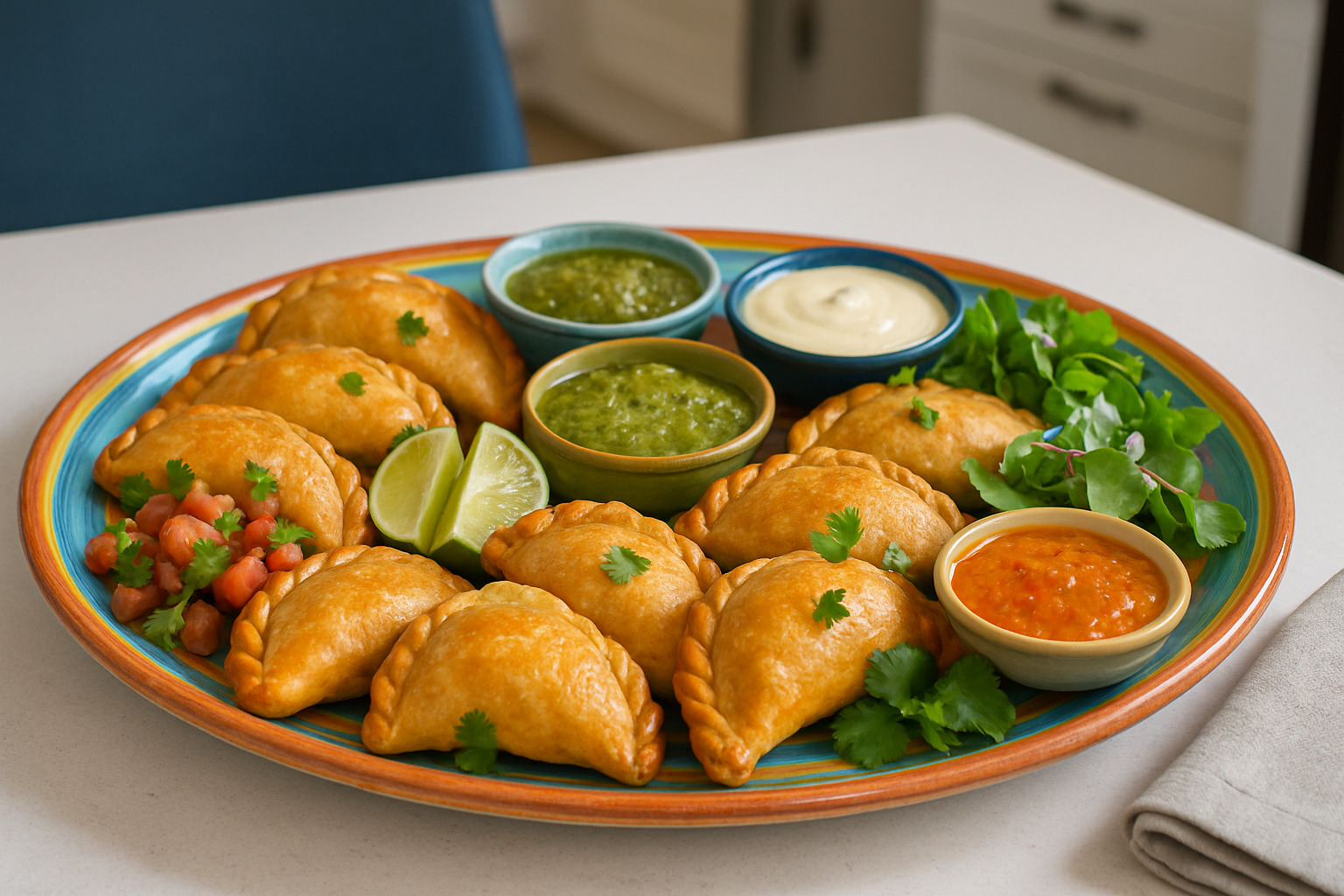
The right drink transforms your empanada experience. Argentine Malbec pairs beautifully with beef empanadas, while crisp Sauvignon Blanc complements lighter varieties. Traditional beverages like mate, horchata, and fresh fruit juices add authentic charm.
Beer lovers should try light lagers with fried empanadas or hoppy IPAs with spicier varieties. Side dishes should provide balance – fresh salads with citrus vinaigrette, rice and beans for hearty meals, or pickled vegetables for tangy contrast.
Frequently Asked Questions about Empanadas
What dough is best for crispy empanadas?
The secret to perfectly crispy empanadas lies in your dough recipe and technique. For maximum crispiness, include fat – either butter or lard works beautifully. Adding a tablespoon of vinegar makes the dough extra flaky by breaking down gluten slightly.
Handle dough gently to avoid developing too much gluten, which creates tough empanadas. Mix just until dough comes together, then refrigerate for at least 30 minutes. Frying at 350°F gives the ultimate crispy texture, though properly made baked empanadas can also achieve good crispiness with egg wash.
Can I bake empanadas instead of frying them?
Absolutely! Baking empanadas is healthier and still delicious. Preheat oven to 400°F and brush empanadas with egg wash for golden color. Bake for 20-25 minutes until golden brown and hollow-sounding when tapped.
Baked empanadas contain significantly fewer calories and less fat than fried versions while maintaining all the flavors you love.
How do I store and reheat leftover empanadas?
Store cooked empanadas in the refrigerator for up to 3 days in an airtight container, or freeze for up to 3 months. For reheating, use the oven at 350°F for 10-15 minutes to restore crispy texture. Add 5-10 extra minutes if reheating from frozen. Avoid microwaving as it makes pastry soggy.

Conclusion
Empanadas represent more than just delicious pastry – they’re a testament to how food travels, adapts, and brings people together across cultures. From their medieval Spanish origins to modern interpretations in food trucks across New York City, these versatile turnovers have proven their staying power by continuously evolving while maintaining their essential character.
What makes empanadas so special is how they’ve become a universal language of comfort food. Whether you’re drawn to traditional Argentine beef empanadas or excited to try fusion varieties, there’s an empanada for every palate. The beauty lies in their accessibility – enjoy them as street food, make them at home, or find authentic versions during travels.
These golden pastries offer something magical: they’re simultaneously exotic and familiar, sophisticated and simple. Making empanadas at home connects you to centuries of culinary tradition, while trying regional varieties opens doors to deeper cultural understanding.
At The Dining Destination, we believe that understanding foods like empanadas opens doors to deeper cultural connections and more meaningful travel experiences. These handheld treasures offer a perfect introduction to the cuisines of Latin America, Spain, and beyond.
Ready to start on your own empanada journey? Start by trying different varieties at local restaurants, experiment with homemade versions using our techniques, or plan a culinary journey to experience them in their native settings. For inspiration on where to find the world’s best empanadas and other culinary treasures, explore our Best Food Destinations guide. Your next great food trip might be just one perfectly crimped empanada away!

